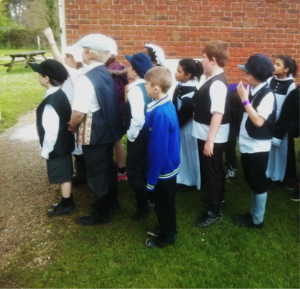03.02.17Pairing Reading Reconsidered Techniques with Cognitive Science, Part II—A Guest Post from Ben Rogers

Pupils from Norwitch Academy dressed as Victorians on a workhouse trip
This is the second of a pair of posts by Ben Rogers of Norwich Primary Academy (NPA) in Norwich, England. In his first post, Ben described the tools he and his colleagues have been using from Reading Reconsidered and cognitive science to bolster students’ reading and writing skills. In this post, he reflects on the power of intentionally building students’ background knowledge and vocabulary.
By the way, we love Ben’s blog, Reading for Learning.
Developing children into skilled readers is only half of the solution: they also need to become more knowledgeable. Helping students make meaning from difficult texts involves several difficult tasks: decoding is only the first step. To comprehend a text, readers must apply what they read to what they already know about the world. Retrieving well-learnt knowledge is easy. Retrieving half-remembered knowledge is much harder.
As in most primary schools, our pupils study important historical, geographical, and scientific knowledge from the day they joined the school. They learn about volcanoes, rain forests, China, the Aztecs, the ancient world, and the history of cities in Britain. Their scientific knowledge includes: forces, electricity, habitats, and chemical reactions. The problem is, once a topic is finished, we move on to the next one. We never revisit it.
This isn’t an effective way to teach. By the time our pupils reach year 6, they possess a jumble of half-remembered knowledge that they struggle to recall and apply. We wanted to exploit the knowledge our children already have. Christine Counsell, our Trust’s Director of Education, named this our “knowledge reheat.” Our strategy is to use reading lessons to reheat our children’s knowledge, and then to develop it.
In January, my colleague Dominic Cozzi attended a course in Cambridge run by the Learning Scientists (learningscientists.org), cognitive psychology scientists interested in research on education. Dominic returned with strategies to reheat and develop our pupils’ knowledge—to make them better readers.
Our reheat strategy combines what cognitive psychologists call retrieval practice—recalling prior knowledge to make it easier to recall on future occasions—with elaboration—making new connections between existing ideas. Both of these are effective learning strategies.
Pupils must be able to effortlessly recall relevant knowledge to make meaning from challenging texts. But they will struggle to recall and apply what they’ve learned in previous years unless they practice remembering it. Alongside quizzes (good for simple retrieval), we use reading to give students practice recalling complex ideas, such as social class, power, and exploration.
To help our pupils make new connections between existing knowledge (for example, comparing slavery in Roman society to the conditions in the Victorian workhouse), we ask them to connect themes in one text with similar themes in others (similar to the technique of Embedded Non-Fiction from Reading Reconsidered).
Our first reheat was about the Victorian era. Back in year 4, the children visited Gressenhall, a Victorian workhouse and museum. I found a folder of old photos from this visit. The children dressed up as Victorian children, picking stones from a chilly Norfolk field and studying in a severe Victorian classroom. The children were fascinated by these images of themselves. Unprompted, they began discussing the Victorians in the playground and the corridors.
We followed initial reheating by studying a well-known painting of a Victorian London street scene by Ford Madox Brown, and then we combined it with a sophisticated text we found at Khan Academy.
Combining the painting and the text allowed us to discuss and write about knowledge specific to the subject, but also to start thinking about broader themes that we would return to in subsequent texts.
Pairing techniques from Reading Reconsidered and cognitive psychology has produced a model that is working well for us. There is a buzz around reading in year 6. Our pupils are excited by texts that contain important ideas, and the reheat helps them experience success with these topics before they even begin reading. My year 6 colleagues and I are excited by the rapid progress our students are making (as reflected by their performance during lessons and on assessments). Years 4 and 5 teachers and pupils are reporting similar progress. We have reasons to be optimistic about how they’ll do on their exams in May.
Here’s a recap of my tips:
- The reheat is important. Photos of the pupils on trips, old exercise books and art are great stimuli. Find the specifics of what they learnt and did (my pupils were very keen to tell me who played which role in a drama about Boudica in year 4). Don’t forget about the children who weren’t there.
- Plan the wider themes, then choose texts to explore them. The texts should practice knowledge retrieval and develop vocabulary.
- It wasn’t until I began working with my colleagues – planning, coaching and observing – that my teaching of reading really developed.
